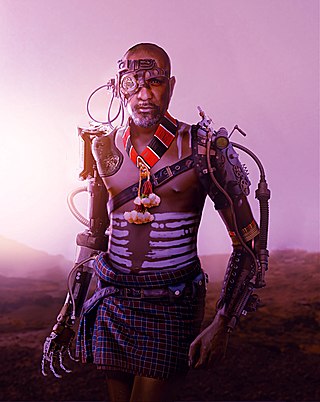
Afrofuturism is a cultural aesthetic, philosophy of science, and history that explores the intersection of the African diaspora culture with science and technology. It addresses themes and concerns of the African diaspora through technoculture and speculative fiction, encompassing a range of media and artists with a shared interest in envisioning black futures that stem from Afro-diasporic experiences. While Afrofuturism is most commonly associated with science fiction, it can also encompass other speculative genres such as fantasy, alternate history and magic realism. The term was coined by American cultural critic Mark Dery in 1993 and explored in the late 1990s through conversations led by Alondra Nelson.

Faith Ringgold was an American painter, author, mixed media sculptor, performance artist, and intersectional activist, perhaps best known for her narrative quilts.
Wangechi Mutu is a Kenyan American visual artist, known primarily for her painting, sculpture, film, and performance work. Born in Kenya, Mutu now splits her time between her studio there in Nairobi and her studio in Brooklyn, New York, where she has lived and worked for over 20 years. Mutu's work has directed the female body as subject through collage painting, immersive installation, and live and video performance while exploring questions of self-image, gender constructs, cultural trauma, and environmental destruction and notions of beauty and power.

Jochen Zeitz is a businessman serving as the president, CEO and chairman of the board of Harley-Davidson, Inc. He is also Chairman of LiveWire Inc. Before that, he served as the chairman and CEO of Puma for 18 years. He also served as board member of Kering, the luxury goods company and chaired their Sustainability Committee, for whom he developed its global sustainability strategy. Zeitz is currently a board member of Harley Davidson, The B Team and Cranemere. In addition to this, Zeitz previously served on the board of Wilderness Safaris. Jochen Zeitz is also the co-founder of The B Team with Richard Branson, Zeitz Museum of Contemporary Art Africa and Founder of the Zeitz Foundation to support sustainable solutions that balance conservation, community, culture and commerce, and The Long Run.

Black science fiction or black speculative fiction is an umbrella term that covers a variety of activities within the science fiction, fantasy, and horror genres where people of the African diaspora take part or are depicted. Some of its defining characteristics include a critique of the social structures leading to black oppression paired with an investment in social change. Black science fiction is "fed by technology but not led by it." This means that black science fiction often explores with human engagement with technology instead of technology as an innate good.
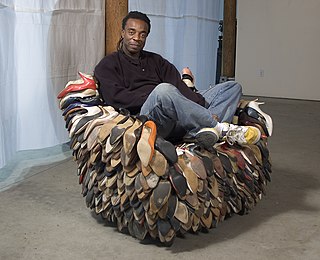
Willie Cole is a contemporary American sculptor, printer, and conceptual and visual artist. His work uses contexts of postmodern eclecticism, and combines references and appropriation from African and African-American imagery. He also has used Dada’s readymades and Surrealism’s transformed objects, as well as icons of American pop culture or African and Asian masks.
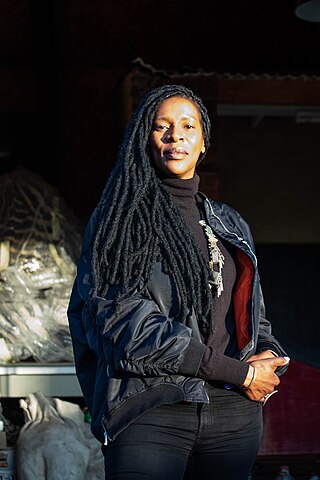
Nandipha Mntambo is a South African artist who has become famous for her sculptures, videos and photographs that focus on human female body and identity by using natural, organic materials. Her art style has been self described as eclectic and androgynous. She is best known for her cowhide sculptures that connects the human form to nature.
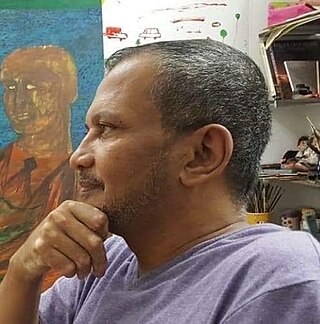
Salah Elmur also spelled Salah El Mur is a contemporary Sudanese painter, graphic designer, author, and filmmaker, who lives and works in Cairo, Egypt. His paintings have been exhibited in Sudan, the Middle East, East Africa, Europe and the United States and are held in notable museum collections, including the Museum of African Contemporary Art Al Maaden (MACAAL) in Marrakesh, the Sharjah Art Foundation (SAF) in the UAE, the Zeitz Museum of Contemporary Art Africa MOCAA in Cape Town, the Minneapolis Institute of Art (MIA) and the Centre Pompidou in Paris.
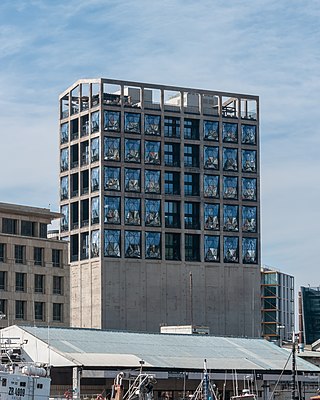
Zeitz Museum of Contemporary Art Africa is a public non-profit museum in Cape Town, South Africa. Zeitz MOCAA opened on September 22, 2017 as the largest museum of contemporary art from Africa and its diaspora. The museum is located in the Silo District at the Victoria & Alfred Waterfront in Cape Town. A retail and hospitality property, the Waterfront receives around 24 million local and international visitors per year.

Sethembile Msezane is a South African visual artist, public speaker and performer who is known for her work within fine arts. Msezane uses her interdisciplinary practice which combines photography, film, sculpture, and drawing to explore issues focused on spirituality, politics and African knowledge systems. Part of her works focus has been on the process of myth-making and its influence on constructing history as well the absence of the black female body in both narrative and physical spaces of historical commemoration. Msezanes work is held in galleries in South Africa as well as internationally and has won awards and nominations. Msezane is a member of the iQhiya Collective, a network of black women artists originating from Cape Town, Johannesburg and across South Africa.
Rosemary Namuli Karuga was a Kenyan visual artist. In 2017, she was named Artist of the Month by the National Museums of Kenya. She is known to be the first woman artist to have studied at Makerere University.
African design encompasses many forms of expression and refers to the forms of design from the continent of Africa and the African diaspora including urban design, architectural design, interior design, product design, art, and fashion design. Africa's many diverse countries are sources of vibrant design with African design influences visible in historical and contemporary art and culture around the world. The study of African design is still limited, particularly from the viewpoint of Africans, and the opportunity to expand its current definition by exploring African visual representations and introducing contemporary design applications remains immense.

Fabiola Jean-Louis is a Haitian artist working in photography, paper textile design, and sculpture. Her work examines the intersectionality of the Black experience, particularly that of women, to address the absence and imbalance of historical representation of African American and Afro-Caribbean people. Jean-Louis has earned residencies at the Museum of Art and Design (MAD), New York City, the Lux Art Institute, San Diego, and the Andrew Freedman Home in The Bronx. In 2021, Jean-Louis became the first Haitian woman artist to exhibit at the Metropolitan Museum of Art. Fabiola lives and works in New York City.
Gerald Machona is a Zimbabwean contemporary visual artist. The most recognizable aspect of his work is his use of decommissioned Zimbabwean dollars. Machona works in sculpture, performance, new media, photography and film. In Machona's work, he explores issues of migration, transnationality, social interaction and xenophobia in South Africa.

Before Yesterday We Could Fly: An Afrofuturist Period Room is an art exhibition at the Metropolitan Museum of Art in New York City. The exhibit, which opened on November 5, 2021, uses a period room format of installation to envision the past, present, and future home of someone who lived in Seneca Village, a largely African American settlement which was destroyed to make way for the construction of Central Park in the mid-1800s.
Thania Petersen is a multi-disciplinary artist. Her work is in the collections of notable museums and galleries including the Smithsonian's National Museum of African Art and the Zeitz Museum of Contemporary Art Africa.
Michelle D. Commander is a historian and author, and serves as Deputy Director of Research and Strategic Initiatives at the Schomburg Center for Research in Black Culture.
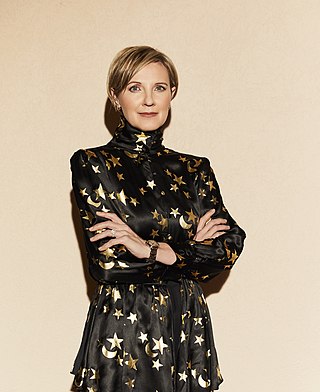
Elana Brundyn is a fine art and cultural consultant based in Cape Town, South Africa. She has previously worked as a commercial gallerist and a museum director.
Jamal Cyrus is an American conceptual artist who works in a range of media, including drawing, sculpture, textiles, assemblage, installation, performance, and sound. His artistic and research practices investigates the history, culture, and identity of the United States, questioning conventional narratives and foregrounding Black political movements, social justice concerns, and the experiences and impact of the African diaspora, including Black music.












